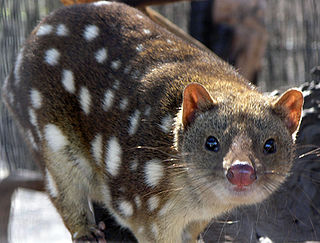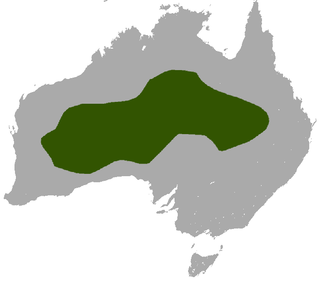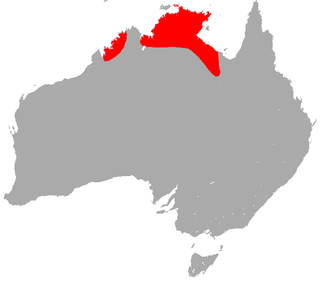
The Dasyuridae are a family of marsupials native to Australia and New Guinea, including 71 extant species divided into 17 genera. Many are small and mouse-like or shrew-like, giving some of them the name marsupial mice or marsupial shrews, but the group also includes the cat-sized quolls, as well as the Tasmanian devil and the extinct thylacine. They are found in a wide range of habitats, including grassland, underground, forests, and mountains, and some species are arboreal or semiaquatic. The Dasyuridae are often called the 'marsupial carnivores', as most members of the family are insectivores.
The former subfamily Planigalinae contained the planigales and the ningauis: very small marsupial carnivores native to Australia which are, like the quolls, antechinuses, dibblers, Tasmanian devil, and many others, part of the biological order Dasyuromorphia: the carnivorous marsupials. The subfamily is now contained in the Sminthopsinae subfamily, and the two genera are split between two different tribes; the planigales are by themselves in their own tribe, while the ningaui are lumped with the dunnarts and the Kultarr.

The common planigale, also known as the pygmy planigale or the coastal planigale, is one of many small marsupial carnivores known as "marsupial mice" found in Australia. There they fill a similar niche to the insectivores of other parts of the world.

The Wongai ningaui is a tiny carnivorous marsupial native to the arid open grasslands of inland Australia. Their diet is mainly small insects, and occasionally larger prey such as spiders, grasshoppers and cockroaches, which they forage for at the ground and in clumps of spinifex. They have long and untidy fur, grey or gingery brown with longer black hairs, small ears, a narrow muzzle, and possess a partially prehensile tail and feet that allow them to climb. The population occurs sparsely across a wide area and common in favourable habitat, especially in years of good rainfall. Ningaui ridei was first described in 1975, one of two species of a new genus discovered amongst the poorly known mammals of the western regions of Australia.

The subfamily Sminthopsinae includes several genera of small, carnivorous marsupials native to Australia: kultarrs, ningauis, dunnarts, and planigales.

The red-cheeked dunnart is so called because of the distinctive red hair on its cheek. It is an Australasian marsupial. Its total length is 167–270 mm (6.6–10.6 in); its average body length is 80–135 mm (3.1–5.3 in) with a tail of 87–135 mm (3.4–5.3 in). Ear length is 12–13 mm (0.47–0.51 in). Its weight varies between 18 and 75 g. Its tail is thin and pale pink.

The striped possum or common striped possum is a member of the marsupial family Petauridae. It is found mainly in New Guinea. The species is black with three white stripes running head to tail, and its head has white stripes that form a 'Y' shape. It is closely related to the sugar glider, and is similar in appearance.

The Pilbara ningaui, sometimes known as Ealey's ningaui, is a tiny species of marsupial carnivore found in Australia.

The paucident planigale, also known as Giles' planigale, is a very small species of carnivorous marsupial of the family Dasyuridae.

The narrow-nosed planigale is a species of very small marsupial carnivore of the family Dasyuridae.

The genus Planigale are small carnivorous marsupials found in Australia and New Guinea. It is the only genus in the tribe Planigalini of the subfamily Sminthopsinae. The genus has long been known to contain several cryptic species. Of the five Planigale species currently recognized, two are known species complexes. The seven species currently recognized are:

The antilopine kangaroo, also known as the antilopine wallaroo or the antilopine wallaby, is a species of macropod found in northern Australia: in Cape York Peninsula in Queensland, the Top End of the Northern Territory, and the Kimberley region of Western Australia. It is a locally common, gregarious grazer.

The northern or sandy nail-tail wallaby is a species of macropod found across northern Australia on arid and sparsely wooded plains. The largest species of the genus Onychogalea, it is a solitary and nocturnal herbivorous browser that selects its food from a wide variety of grasses and succulent plant material. Distinguished by a slender and long-limbed form that resembles the typical and well known kangaroos, although their standing height is shorter, around half of one metre, and their weight is less than nine kilograms. As with some medium to large kangaroo species, such as Osphranter rufus, they have an unusual pentapedal motion at slow speeds by stiffening the tail for a fifth limb. When fleeing a disturbance, they hop rapidly with the tail curled back and repeatedly utter the sound "wuluhwuluh". Their exceptionally long tail has a broad fingernail-like protuberance beneath a dark crest of hair at its end, a peculiarity of the genus that is much broader than the other species. The name unguifera, meaning claw, is a reference to this extraordinary attribute, the purpose of which is unknown.
The northern cave bat is a vesper bat that occurs throughout most of Australia.
The yellow-lipped cave bat is a vesper bat that only occurs in the Kimberley region of northwest Australia. The bat was first captured at Tunnel Creek in 1958 and a description published nearly twenty years later. Aside from observations of their physical characteristics, a preference for caves, and hunting insects over streams, little is known of the species.
The Forrest's mouse, or desert short-tailed mouse, is a small species of rodent in the family Muridae. It is a widespread but sparsely distributed species found across arid and semi-arid inland Australia, commonly found in tussock grassland, chenopod shrubland, and mulga or savannah woodlands.

The Arnhem sheath-tailed bat, species is an emballonurid bat found at the Top End of Australia. The species is also referred to as the white-striped sheathtail for the distinguishing marks at the flank, a feature observable beneath the wing when the animal is in flight. Records of the species are rare.

The rufous owl, also known as the rufous boobook, is a species of owl in the family Strigidae. It was described in 1846 by John Gould, an English ornithologist. Its common name reflects the rufous-coloured feathers that these owls are covered with in adulthood. While it is uncommon, the species has a wide range, including Australia, Indonesia, and Papua New Guinea.

The northern leaf-nosed bat is a micro-bat of the family Hipposideridae, known as "leaf-nosed" bats. The species is endemic to northern regions of Australia. They are highly manoeuvrable in flight, and use echolocation to forage for insect prey.















